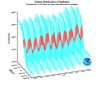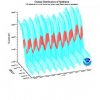From Wikipedia-
From 986 AD, Greenland's west coast was colonised by Icelanders and Norwegians in two settlements on fjords near the southwestern-most tip of the island.[SUP][9][/SUP] They shared the island with the late Dorset culture inhabitants who occupied the northern and eastern parts, and later with the Thule culture arriving from the north. Norse Greenlanders submitted to Norwegian rule in the 13th century, and the kingdom of Norway entered into a personal union with Denmark in 1380 and from 1397 was a part of the Kalmar Union.[SUP][10][/SUP]
The settlements, such as Brattahlíð, thrived for centuries but disappeared some time in the 15th century, perhaps at the onset of the Little Ice Age.[SUP][11][/SUP] Interpretation of ice core and clam shell data suggests that between 800 and 1300 AD the regions around the fjords of southern Greenland experienced a relatively mild climate several degrees Celsius higher than usual in the North Atlantic,[SUP][12][/SUP] with trees and herbaceous plants growing and livestock being farmed. Barley was grown as a crop up to the 70th degree.[SUP][13][/SUP] What is verifiable is that the ice cores indicate Greenland has experienced dramatic temperature shifts many times over the past 100,000 years.[SUP][14][/SUP] Similarly the Norse Book
Alright - offically my care factor is 0 for Greenland's ice melting... Somone just bottle it and sell it.























